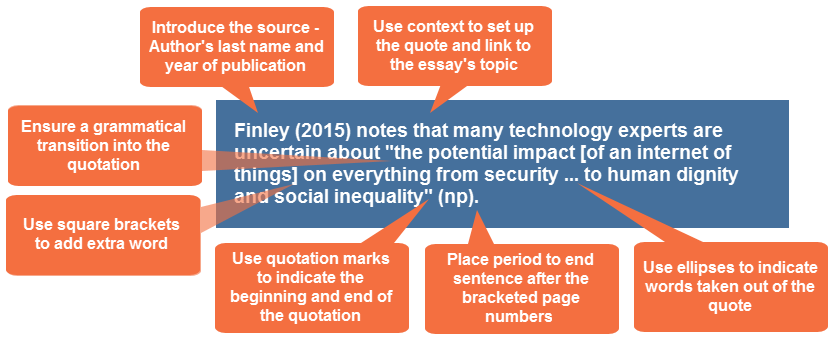One of the ways we incorporate other people’s work into our writing is through direct quotation. Direct quotation is when we take the exact words (or an image, or data) and replicate them in our work.
When you insert a direct quotation into your work, you are interrupting your words and inserting someone else’s. This can be a powerful thing to do. But it can also be disruptive to the writing. It’s important not to include too many direct quotations in your work as this can be distracting and make your paper difficult to read.
You should have a good reason for using a direct quotation, such as to highlight unique or interesting language or to reinforce the authority of the source.
Let’s look at an example of how to build quotes into your writing.

In the example, the writer includes a quotation from an article by Klint Finley. After reading this quote in the essay, the reader could turn to the Reference List and find this citation:
Finley, K. (2015). Why tech’s best minds are very worried about the Internet of things. WIRED. Retrieved 8 October 2015, from http://www.wired.com/2014/05/iot-report/
Now, take note of the key features of the direct quotations above:
- Introduce quotations. Avoid dropping them unannounced into your writing. Use a language of attribution – such as the phrase “Finley notes that” – and in-text citation to do this.
- Write grammatical sentences when incorporating quotations. Use punctuation and the necessary transition language to make an effective sentence.
- Use quotation marks to indicate which words are part of the quotation. Include the page number if there is one, or np to indicate no page numbers. Notice the period comes after the page number.
- Use square brackets to indicate information has been added to a quote – sometimes necessary for clarity or grammatical accuracy.
- Use ellipses to remove information from a quote – sometimes necessary for clarity or grammatical accuracy. Make sure you never change the intended meaning of a quotation.
This model demonstrates the basic approach to incorporating quotations. As you get more involved in documenting research material, you are encouraged to refer to the APA reference guide and/or your school’s library for more details.
Now, let’s practice building a quotation into some writing.

